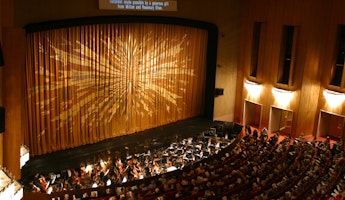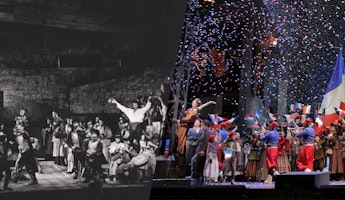Blog
September 16, 2024
The Hays Code and The Golden Age of Hollywood in "Madame Butterfly"
This is a guest blog by the Executive Director of Asian Opera Alliance, Melody Chang
While Asian Americans have long suffered from underrepresentation in media, Hollywood has been the epicenter of inequities from its inception. However, Asians have played many important roles in the development of the film industry, particularly during the Golden Age of Hollywood. Many Asian American actors disappeared and reappeared throughout this era as a response to systemic corruption and waves of anti-Asian sentiment in America. Studios assumed that American audiences would not respond well to all-Asian casts, which led to many films utilizing yellowface instead of casting Asian actors.
Anna May Wong, possibly the most well-known Asian American starlet from this era, was forced to portray tragic or evil side characters that perpetuated harmful Asian stereotypes. She was driven to seek work in Europe, as she found that they were more open to an Asian leading lady. Merle Oberon, an actress with Māori ancestry, hid her heritage from Hollywood in order to portray leading roles in movies. She used skin bleaching products, invented a backstory, and changed her name to become white-passing actress. Etta Lee appeared in films only as a maid, manicurist, or slave. However, in 1923, Motion Picture Classics complained that her name was not exotic enough and criticized her for not speaking Chinese. Toshia Mori was selected by the Western Association of Motion Picture Advertisers to become the only person of color ever to be featured as a WAMPAS Baby Star, which was an honor that launched the careers of the likes of Joan Crawford, Ginger Rogers, and Clara Bow. Even with this star-making honor, she was consistently misidentified in publicity promotions and subjected to racist mock Asian accents from announcers and interviewers. She stopped making films at just 26 years old.
The Golden Age of Hollywood was a time of growth and experimentation, seeing the transition from silent films to “talkies” and acting as an escape for Americans through the Great Depression. This era included a system that allowed studios to exercise complete control over their actors. The affluence of the 1920s and the economic crash of 1929 led to an industry-wide pendulum swing that saw the introduction of the Hays Code in the 1930s, which was meant to act as a self-policing guide for the movies produced by Hollywood studios. These studios were bound by this voluntary set of rules for censorship, which prohibited content deemed immoral, including profanity, sex, nudity, blasphemy, and miscegenation. Any film with mixed-race actor portraying a relationship was essentially barred from public release.
As this production of Madame Butterfly takes place on a 1930s soundstage, LA Opera and the Asian Opera Alliance deemed it important to cast to the sensibilities of today. To accurately reflect Hollywood in the 1930s would be perpetuating a racist system and further decenter the story from Asian-identifying people. We propose a different reality – what if the Hays Code never came into effect? What if there had been less discrimination in the early days of Hollywood? With the depiction of interracial romance, the film being created onstage at LA Opera would have never been released to the public.
It is important to note that with all films, this production is not meant to serve as a completely accurate representation of Japanese culture either. While we have sought guidance from kimono and Japanese cultural experts, Sueko Oshimoto and Kentaro Terauchi, we have also worked together to review aspects of Cio-Cio San's attempt to combine her culture with Pinkerton's. You may notice a westernized tea pot on Cio-Cio's tea tray in Act II but note the inclusion of a Japanese tea set and the lack of saucers and a sugar dish, indicating that she is serving a traditional Japanese tea. Those who arrive early will notice the soundstage being set up prior to the show, including a discovery of a prop Buddha from the original Spanish production, to which our Asian-identifying female script supervisor indicates is incorrect for this story, as Shinto religion would have been more prevalent at this time. The Shinto wedding tradition of san san kudo, drinking three times from three sake cups, has also been incorporated into Cio-Cio San and Pinkerton's wedding in Act I. This is an old Shinto tradition dating back to the 1600s, so there are many different interpretations of the exact symbolism of each cup, though our production has adopted the interpretation that the first cup represents their union, the second cup represents recognition of their flaws, and the third cup represents moving forward from those flaws together. Note that Pinkerton is interrupted while he is drinking from the third cup.
While there is no way to fully heal the discriminatory practices of Hollywood, this production is an offering and love letter to a slice of what Hollywood could have been without rampant discrimination. We invite you, an audience member in 2024, to join us in the 1930s – with a very important twist. Where would we be today as a society if Hollywood had allowed room for those of different backgrounds, having grown up seeing all different types of people and culture represented onstage?








/03-cosi/_dsc0996_pr.jpg?format=auto&fit=crop&w=345&h=200&auto=format)















